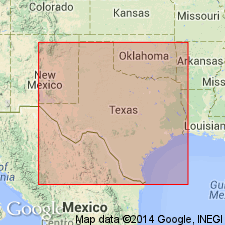
- Usage in publication:
-
- Big Bend Park Group
- Modifications:
-
- Areal extent
- AAPG geologic province:
-
- Permian basin
Summary:
Pg. 12-33, pIs., tables, road logs. Big Bend Park Group. Consists of (ascending) Canoe Formation (new), Chisos Formation, and South Rim Formation (new). Overlies Tornillo Group. Age is middle Eocene to Oligocene or younger.
Source: US geologic names lexicon (USGS Bull. 1350, p. 64).

- Usage in publication:
-
- Big Bend Park Group
- Modifications:
-
- Principal reference
- AAPG geologic province:
-
- Permian basin
Summary:
Pg. 107-151, pls. Big Bend Park Group. Formal proposal of name. Includes the Tertiary volcanic rocks exposed in Big Bend National Park. Comprises (ascending) Canoe Formation, Chisos Formation, and South Rim Formation. These are formed of massive coarse conglomerate, sandstone, clay, fresh-water limestone, tuff, tuffaceous sandstone and clay, flow breccia, and lava. Complete uninterrupted section not preserved. Only basal unit, Canoe Formation, has been precisely dated. Age is middle Eocene to Oligocene or younger.
Named from Big Bend National Park, Brewster Co., southwestern TX.
Source: US geologic names lexicon (USGS Bull. 1350, p. 64).
For more information, please contact Nancy Stamm, Geologic Names Committee Secretary.
Asterisk (*) indicates published by U.S. Geological Survey authors.
"No current usage" (†) implies that a name has been abandoned or has fallen into disuse. Former usage and, if known, replacement name given in parentheses ( ).
Slash (/) indicates name conflicts with nomenclatural guidelines (CSN, 1933; ACSN, 1961, 1970; NACSN, 1983, 2005, 2021). May be explained within brackets ([ ]).

